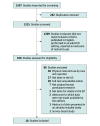Racial Disparities in Emergency Department Physical Restraint Use: A Systematic Review and Meta-Analysis
- PMID: 37747721
- PMCID: PMC10520842
- DOI: 10.1001/jamainternmed.2023.4832
Racial Disparities in Emergency Department Physical Restraint Use: A Systematic Review and Meta-Analysis
Abstract
Importance: Recent studies have demonstrated that people of color are more likely to be restrained in emergency department (ED) settings compared with other patients, but many of these studies are based at a single site or health care system, limiting their generalizability.
Objective: To synthesize existing literature on risk of physical restraint use in adult EDs, specifically in reference to patients of different racial and ethnic backgrounds.
Data sources: A systematic search of PubMed, Embase, Web of Science, and CINAHL was performed from database inception to February 8, 2022.
Study selection: Included peer-reviewed studies met 3 criteria: (1) published in English, (2) original human participants research performed in an adult ED, and (3) reported an outcome of physical restraint use by patient race or ethnicity. Studies were excluded if they were conducted outside of the US, or if full text was unavailable.
Data extraction and synthesis: Four independent reviewers (V.E., M.M., D.D., and A.H.) abstracted data from selected articles following Meta-Analysis of Observational Studies in Epidemiology guidelines. A modified Newcastle-Ottawa scale was used to assess quality. A meta-analysis of restraint outcomes among minoritized racial and ethnic groups was performed using a random-effects model in 2022.
Main outcome(s) and measure(s): Risk of physical restraint use in adult ED patients by racial and ethnic background.
Results: The search yielded 1597 articles, of which 10 met inclusion criteria (0.63%). These studies represented 2 557 983 patient encounters and 24 030 events of physical restraint (0.94%). In the meta-analysis, Black patients were more likely to be restrained compared with White patients (RR, 1.31; 95% CI, 1.19-1.43) and to all non-Black patients (RR, 1.27; 95% CI, 1.23-1.31). With respect to ethnicity, Hispanic patients were less likely to be restrained compared with non-Hispanic patients (RR, 0.85; 95% CI, 0.81-0.89).
Conclusions and relevance: Physical restraint was uncommon, occurring in less than 1% of encounters, but adult Black patients experienced a significantly higher risk of physical restraint in ED settings compared with other racial groups. Hispanic patients were less likely to be restrained compared with non-Hispanic patients, though this observation may have occurred if Black patients, with a higher risk of restraint, were included in the non-Hispanic group. Further work, including qualitative studies, to explore and address mechanisms of racism at the interpersonal, institutional, and structural levels are needed.
Conflict of interest statement
Figures



References
-
- Santo L, Peters ZJ, DeFrances CJ. Emergency department visits among adults with mental health disorders: United States, 2017-2019. NCHS Data Brief. 2021;(426):1-8. - PubMed
-
- Omar H, Yue R. Reassessment of violence against emergency physicians. Ann Emerg Med. 2018;72(4S):S144-S145. doi: 10.1016/j.annemergmed.2018.08.373 - DOI
-
- Emergency Doctors and Nurses Team Up on No Silence on ED Violence Campaign. Accessed May 18, 2022. www.acep.org/administration/violence-in-the-emergency-department-resourc...
Publication types
MeSH terms
LinkOut - more resources
Full Text Sources
Medical
Miscellaneous

